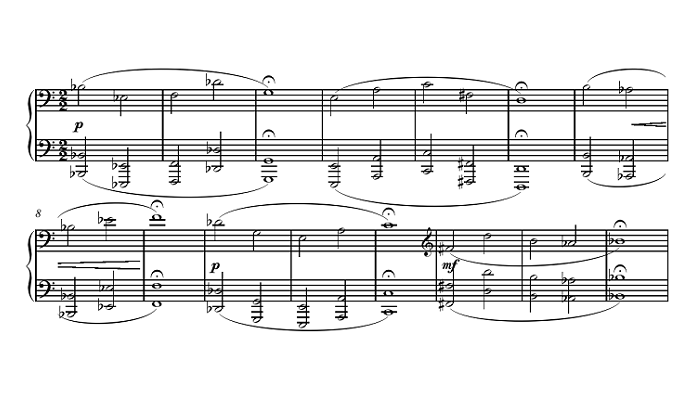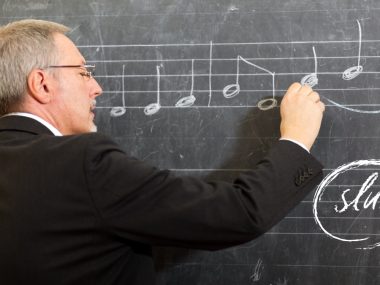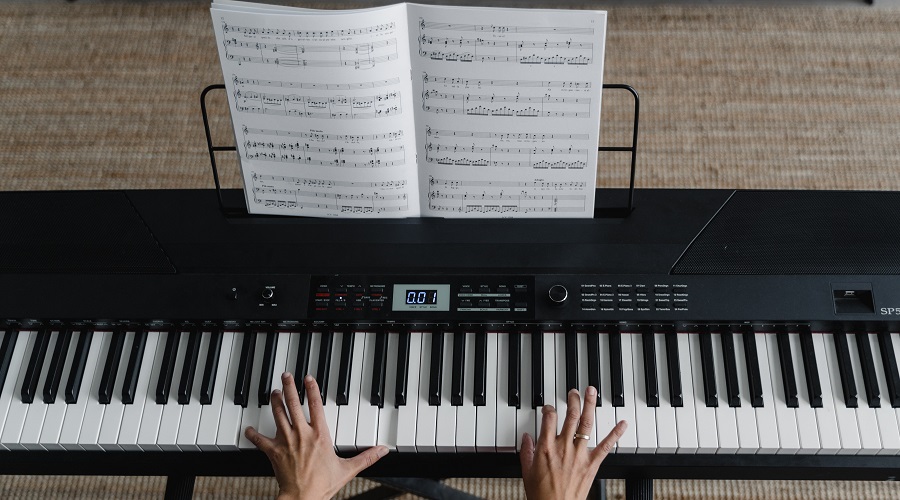Back in 1908, the US only had 46 states, and music was still tonal!
Until Arnold Schoenberg developed atonal music in 1908, all songs and music pieces had a hierarchy to them. They followed a specific system of structures and rules, and they put emphasis on particular notes and left others out.
Atonal music came and proved you don’t need a structure or a hierarchy to make a great piece. It messed with 200-year old beliefs, and surprisingly, it worked!
What Is Atonal Music?
The term atonal refers to music that’s composed without an atonal center.
For example, we all know our musical system has a total of 12 tones. Each tone is a half-step lower or higher than the one after or before it.
The tone range is commonly known in the industry as the chromatic scale, and it contains all the possible notes you can use in a piece. In tonal music, the musicians don’t use the full range. Instead, they only choose one tone and then select the notes that work best for the music’s balance.
The tone they start with is the main tone, so the music is centered around it. And, the range of notes they choose afterward to complement the technique is called the key.
In this case, the music has both a central tone and a key. Atonal music lacks both.
Atonal composers don’t only use one tone of the chromatic scale. Instead, they use the whole scale, trying their luck with the full range of possibilities.
Some people think atonal means you don’t use the same 12 tones from the scale, but you still do. It depends on the regional music.
For example, western atonal music only experiments within the 12 tones. They go through them with ½ steps between each tone.
Meanwhile, Asian music uses ¼ steps instead of ½ steps. So while western music uses the C# between the C and D notes, Asian music has a different tone between C# and C.
Each musical system operates differently, but western atonal music uses the same chromatic scale as tonal music.
How Does Hierarchy Work in Music?

Some composers establish a hierarchy in their songs, so they keep building up for the final moment. Our brains can ingest hierarchical music better than non-hierarchical ones, and it’s much easier to memorize.
For example, think of Mary Had a Little Lamb, which is a staple of our childhood. There’s a constant rhythm throughout the song that reaches its peak in the last note, particularly in the word snow.
You keep humming the rhythm during the whole song until you reach a stop at that last note. While you may think it’s just the way the song goes, it was meant to end like that. The composer places the note C at the top of the pyramid to give that exact feeling.
Atonal music, on the other hand, doesn’t follow a system or a hierarchy. Instead, the composers treat all the tones as equal without emphasizing specific tones, like the C tone in Mary Had a Little Lamb.
That’s why atonal music may sound bad if you’re not used to the concept. Atonal composers’ main aim is to ditch traditionality and create a musical vision of their own. They believe that it sounds alien-like because people are still not used to it. However, let’s face it, some music sounds plain bad!
The Early History of Atonal Music
The first composer who experimented with atonal music is Arnold Schoenberg. To this day, the credits of starting atonal music go to him.
He first started practicing free atonality, which is composing music without a structure or a system. Free atonality also dictates that the music is free of musical gestures or anything that may come close to tonality.
Twelve years after Schoenberg created atonal music, he was teaching music students in Vienna. Together, they worked on new theories of atonality, hoping to develop a structure or a system for music that doesn’t have a tonal hierarchy.
Needless to say, it was a near-impossible task. They were basically trying to create a system for a musical style that Schoenberg originally developed to defy all systems.
Despite that, they succeeded, and they’re known today as the Second Viennese School. It’s called the second as a direct nod to the First Viennese Group of the late 1700s.
Two of the most famous students of this school were Anton Webern and Alban Berg. Together with their teacher, they created the Twelve-Tone Serialism.
What Is the Twelve-Tone Serialism?

The Twelve-Tone Serialism is one way to compose atonal music. The term Serialism referred to the ordering of musical items, such as durations, pitches, etc. Meanwhile, the twelve-tone composition refers to the chromatic scale, which comprises twelve pitch classes or tones.
Twelve Tone Serialism includes creating music with all the 12 tones and without repeating any of them. So, let’s say you already went through all the tones, now you made a row.
After creating a row, you can play it again forward, backward, or flip it upside down. Some composers also choose to transpose it in an up and down motion.
The idea here is to create endless patterns using a single row.
While this indeed seems interesting, listening to this kind of music isn’t exactly fun. A row of twelve tones is simply not singable, and it may not sound pleasant to your ears. You’ll need to keep an open mind and put a lot of concentration to enjoy it, which is one reason it hasn’t gained much popularity.
Twelve Tone Serialism isn’t only hard to listen to, but it’s also hard to play. Trying to communicate emotions using a single row isn’t an easy task.
What’s the People’s Views on Twelve-Tone Serialism?
Twelve-Tone Serialism had a lot of opposers. Some composers simply didn’t accept the idea that someone can create a music piece without a central tone and get away with it! In fact, it stayed hated until the ‘90s, and it’s still not common in the digital era.
Donald Martino once called out composers who use the 12-tone system in 1997, saying he doesn’t want people to be influenced by this style.

The music style was basically facing rejection since the ‘70s. As a result, some atonal music enthusiasts started revolting against these opinions. For example, in 1979, Charles Wuorinen declared that the 12-tone Serialism has forever replaced tonal music.
He said that the tonal system is only used in commercial and popular music and occasionally in some composers’ themes, but all the serious composers replaced it with atonal themes.
Of course, none of that was correct. Atonal music never replaced tonal music, and the Twelve-Tone Serialism had more haters than lovers.
The ‘60s, in particular, saw a lot of backlashes against the 12-tone system. It’s only with the rise of neo-Romanticism, Minimalism, and post-Minimalism approaches to composing that atonal music saw some light. Composers in this era tried combining atonal and tonal elements, which helped normalize the atonal approach a bit.
Examples of Atonal Music Pieces
I bet you’re curious about what atonal music sounds like!
Well, here are some of the most famous pieces composed using the 12-tone system. Who knows? Maybe your opinion will be better than Donald Martino’s!
1935 Violin Concerto – Alban Berg
Alban Berg was one of the leading student composers of the Second Viennese School. So it’s only natural for him to follow his teacher’s steps and compose 12-tone pieces.
His violin concerto was composed in mourning of Manon Gropius after she died of Polio in the same year.
What he didn’t know is, he’d be mourning himself too because he died merely a couple of months later. That’s why the piece has a sense of ambiguity to it.
It uses a 12-note row created of successions of thirds, and it includes the five-note scale. These elements are what give the piece its nostalgic feel. It almost feels tonal, which is why it’s widely recognized and loved, contrary to most atonal pieces.
Variations for Orchestra, Op. 31 – Arnold Schoenberg

Of course, we can’t have a list like this without giving credits to the Godfather of atonal music: Arnold Schoenberg. His first serial work of a full orchestra is basically a demonstration of the 12-tone system.
In the opening of the piece, Schoenberg assembles his row note by note. Then, the cellos start playing four successive forms of the row in different ways: prime, retrograde inversion, retrograde, and then inversion.
Agon – Igor Stravinsky
Stravinsky’s Agon is a popular ballet piece that he kept composing over several years. He started in 1953, but the piece never saw the light until 1957. It’s a 22-minute piece that features 12-tone dances, and it’s one of the most famous atonal pieces because it has a lot of fans.
The piece is a controversial one. It comprises Webern, Monteverdi, Jazz, and even Medieval cadences. Hearing about this, you never imagine you’ll hear something good, but Stravinsky somehow succeeded in creating a balanced piece.







